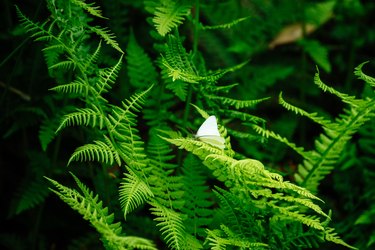
The vast majority of plants on earth produce flowers. The life cycle of flowering plants is fairly straightforward: once pollinated, flowers produce seeds, which contain embryos that grow into new plants. However, the life cycle of a non-flowering plant does not include flowers and in many cases, no seeds, yet they still reproduce and flourish, using their own distinctive methods.
Types of Non-Flowering Plants
Video of the Day
Most non-flowering plants are non-vascular, meaning they lack the internal "piping" system other plants use to transport water and nutrients to plant parts. For this reason, many non-vascular plants must grow in or near water, which they absorb by diffusion through their outer covering. Non-vascular plants have no true stems or leaves and their root-like structures, called rhizoids, mainly serve to anchor them to the ground.
Video of the Day
These plants tend to develop a waxy covering over the stems and leaves, called cuticles, to help the plants retain water. Because they lack a woody support structure, they are often very small. Examples of non-flowering, non-vascular plants include mosses, club mosses, liverworts, algae and seaweed.
Non-flowering vascular plants have true roots, stems and leaves and a complete vascular system and can grow quite large. Examples of these plants include ferns, horse tails and gymnospores or coniferous trees.
Non-Flowering Plant Reproduction
Non-flowering plant reproduction is more complex than that of flowering plants. Simply put, there is an extra step in the process. Instead of going straight from seed to plant to seed again, non-flowering plants reproduce through something called "alternation of generations." This term means that one generation or "stage" of a plant produces half of the genetic material needed to create a new adult plant and the next generation provides the other half.
Sporohyte Function in Reproduction
The adult generation or stage of a non-flowering plant, such as a fern or moss, is called a sporophyte. Sporophytes contain small grain-like particles called spores, which are dispersed from the plant once they reach maturity. If a spore lands in suitable conditions--meaning soil that has enough water and nutrients and the right temperature--it will grow into a small plant called a gametophyte, which is considered the plant's next generation or stage.
Gametophytes and Reproduction
Gametophytes are not small adult plants. They are the non-flowering plant's answer to a seed. Gametophytes contain a plant's gametes or reproductive cells. One part of the gametophyte contains a single egg and another contains sperm. The sperm is flagellated, which means it has a tail-like structure that allows it to swim to the egg through a film of water on or near the plant. Once the sperm fertilizes the egg, a sporophyte grows and the plant's life cycle is complete.
Gymnosperm Reproduction Process
Gymnosperms, which include coniferous trees such as pines, are non-flowering plants that produce seeds. These non-flowering plants produce both male and female cones. The female cones contain egg cells and the male cones contain sperm cells, which are contained in small grains of pollen. When the pollen has matured, it is dispersed into the wind. It blows through the female cones, fertilizing the eggs and creating seeds, which grow into new plants.